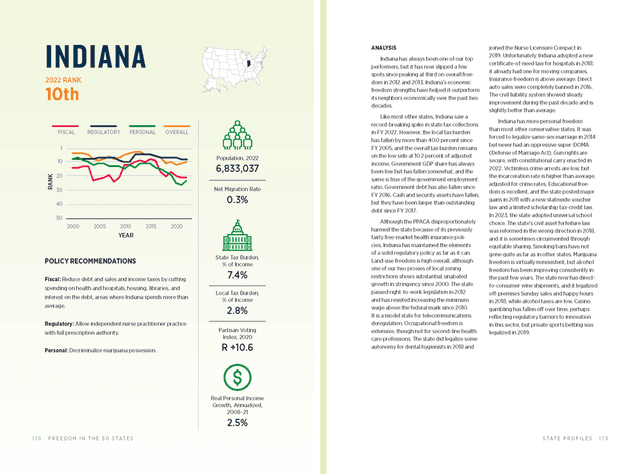Policy Recommendations
- Fiscal Reduce debt and sales and income taxes by cutting spending on health and hospitals, housing, libraries, and interest on the debt, areas where Indiana spends more than average.
- Regulatory Allow independent nurse practitioner practice with full prescription authority.
- Personal Decriminalize marijuana possession.
Analysis
Indiana has always been one of our top performers, but it has now slipped a few spots since peaking at third on overall freedom in 2012 and 2013. Indiana’s economic freedom strengths have helped it outperform its neighbors economically over the past two decades.
Like most other states, Indiana saw a record-breaking spike in state tax collections in FY 2022. However, the local tax burden has fallen by more than 40.0 percent since FY 2005, and the overall tax burden remains on the low side at 10.2 percent of adjusted income. Government GDP share has always been low but has fallen somewhat, and the same is true of the government employment ratio. Government debt has also fallen since FY 2016. Cash and security assets have fallen, but they have been larger than outstanding debt since FY 2017.
Although the PPACA disproportionately harmed the state because of its previously fairly free-market health insurance policies, Indiana has maintained the elements of a solid regulatory policy as far as it can. Land-use freedom is high overall, although one of our two proxies of local zoning restrictions shows substantial, unabated growth in stringency since 2000. The state passed right-to-work legislation in 2012 and has resisted increasing the minimum wage above the federal mark since 2010. It is a model state for telecommunications deregulation. Occupational freedom is extensive, though not for second-line health care professions. The state did legalize some autonomy for dental hygienists in 2018 and joined the Nurse Licensure Compact in 2019. Unfortunately, Indiana adopted a new certificate-of-need law for nursing homes in 2018; it already had one for moving companies. Insurance freedom is above average. Direct auto sales were completely banned in 2016. The civil liability system showed steady improvement during the past decade and is slightly better than average.
Indiana has more personal freedom than most other conservative states. It was forced to legalize same-sex marriage in 2014 but never had an oppressive super-DOMA (Defense of Marriage Act). Gun rights are secure, with constitutional carry enacted in 2022. Victimless crime arrests are low, but the incarceration rate is higher than average, adjusted for crime rates. Educational freedom is excellent, and the state posted major gains in 2011 with a new statewide voucher law and a limited scholarship tax-credit law. In 2023, the state adopted universal school choice. The state’s civil asset forfeiture law was reformed in the wrong direction in 2018, and it is sometimes circumvented through equitable sharing. Smoking bans have not gone quite as far as in other states. Marijuana freedom is virtually nonexistent, but alcohol freedom has been improving consistently in the past few years. The state now has direct-to-consumer wine shipments, and it legalized off-premises Sunday sales and happy hours in 2018, while alcohol taxes are low. Casino gambling has fallen off over time, perhaps reflecting regulatory barriers to innovation in this sector, but private sports betting was legalized in 2019.

